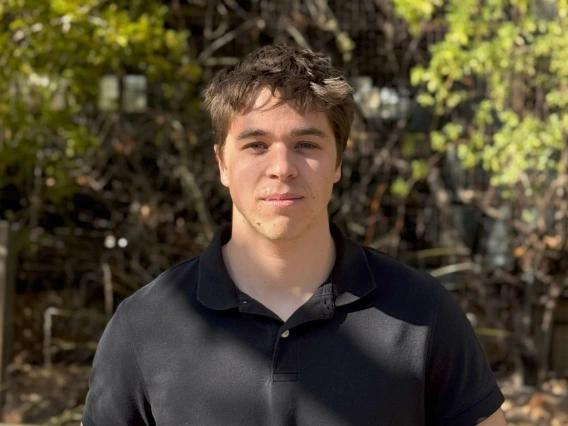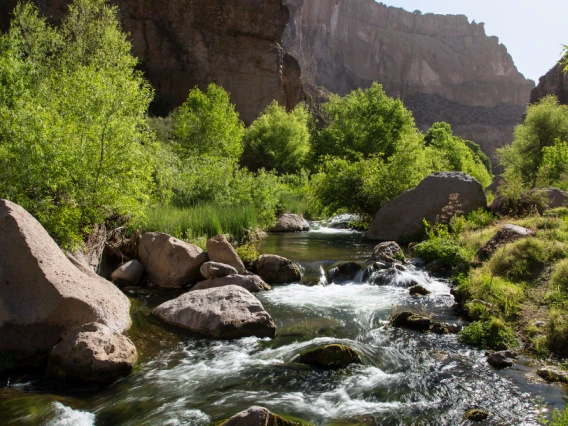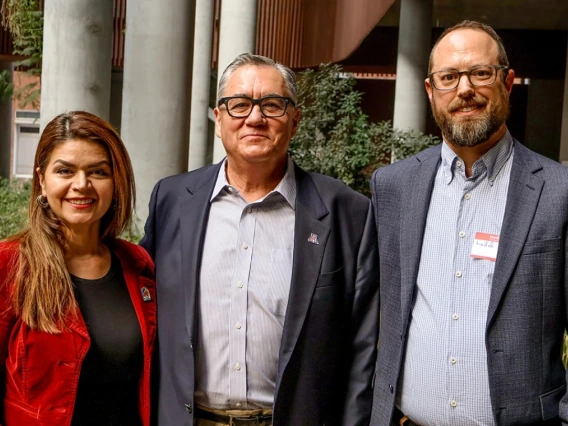Master of Landscape Architecture Students Receive Elizabeth "Liba" Wheat Prize for COVID-Responsive Park Design

The Event Center at Hope Rock Park by Paige Anthony '21 MLA and Ramzy Bejjani '21 MLA, winners of the 2020 Elizabeth "Liba" Wheat Memorial Prize.
How can parks and open space be re-envisioned for a post-COVID-19 era?
That was the challenge for Master of Landscape Architecture students in the 2020 fall semester Design Studio V, taught by Bo Yang, professor of landscape architecture and urban planning in the College of Architecture, Planning and Landscape Architecture.
The reward for crafting an answer to that question? The 2020 Elizabeth “Liba” Wheat Memorial Prize, which recognizes second- and third-year MLA students whose work demonstrates the values of community improvement, innovation in design and transformation of public spaces.
In Yang's studio, teams of two students each selected an existing park or open space area in the Tucson region and spent the semester re-envisioning them for a post-pandemic future. The teams creatively reimagined parks, washes and golf courses as safe gathering spaces with room to physically distance. Some featured outdoor extensions of adjacent public libraries, others included pod-sized gathering areas for families or small groups and some had pathways with subtle nighttime illumination for after-dark activities.
The teams, which were also encouraged to incorporate green infrastructure strategies into their designs to manage stormwater, improve habitat and restore natural processes to the sites, are:
- Grace Stoner '20 MLA and Sean Maccabe '21 MLA: Beware Your Aura: Retrofitting a Popular Parcel Park in the Time of a Global Pandemic
- Paige Anthony '21 MLA and Ramzy Bejjani '21 MLA: Hope Rock Park
- Chelsea Hendryk '21 MLA and Sam Jones '21 MLA: The Radlands on Pantano Wash
- Gabrielle Spickard '21 MLA and Rebecca Shaw '21 MLA: Santa Cruz Desert Discovery Center
On December 9, 2020, following presentations by the MLA student teams, the prize jury selected Hope Rock Park as the winner.
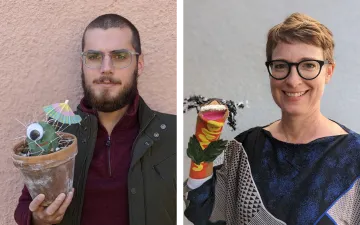
Ramzy Bejjani '21 MLA and Paige Anthony '21 MLA
For Hope Rock Park, Anthony and Bejjani chose a linear open space area five miles south of downtown Tucson along the Santa Cruz River, sandwiched between a residential neighborhood and a large shopping center. Bike paths, benches and a small handmade memorial exist at the site, which is otherwise undeveloped.
In developing their plan, the team came up with a list of questions, including how they could reinforce the community’s connection to the site and how a COVID-19 response could pivot to a post-pandemic world. This led them to create the parti pris that guided their design: “Create a park that, alongside its community, responds, grows and reflects on the COVID-19 pandemic.”
"All memorials inherently endeavor to navigate time, creating a connection between the present and the event in question," says Ramzy. "What we attempted to do with Hope Rock Park was create a space that also fills in the narrative gaps between now and then, and in doing so tells a story about growth and tragedy."
Hope Rock Park Master Plan
Ramzy and Paige chose to design a linear park with improved wildlife habitat and ample open space that would allow for physical distancing. The design includes four focus zones: Play and Exercise Grounds, COVID-19 Response and Event Center, Bird Habitat and Tree Memorial Site.
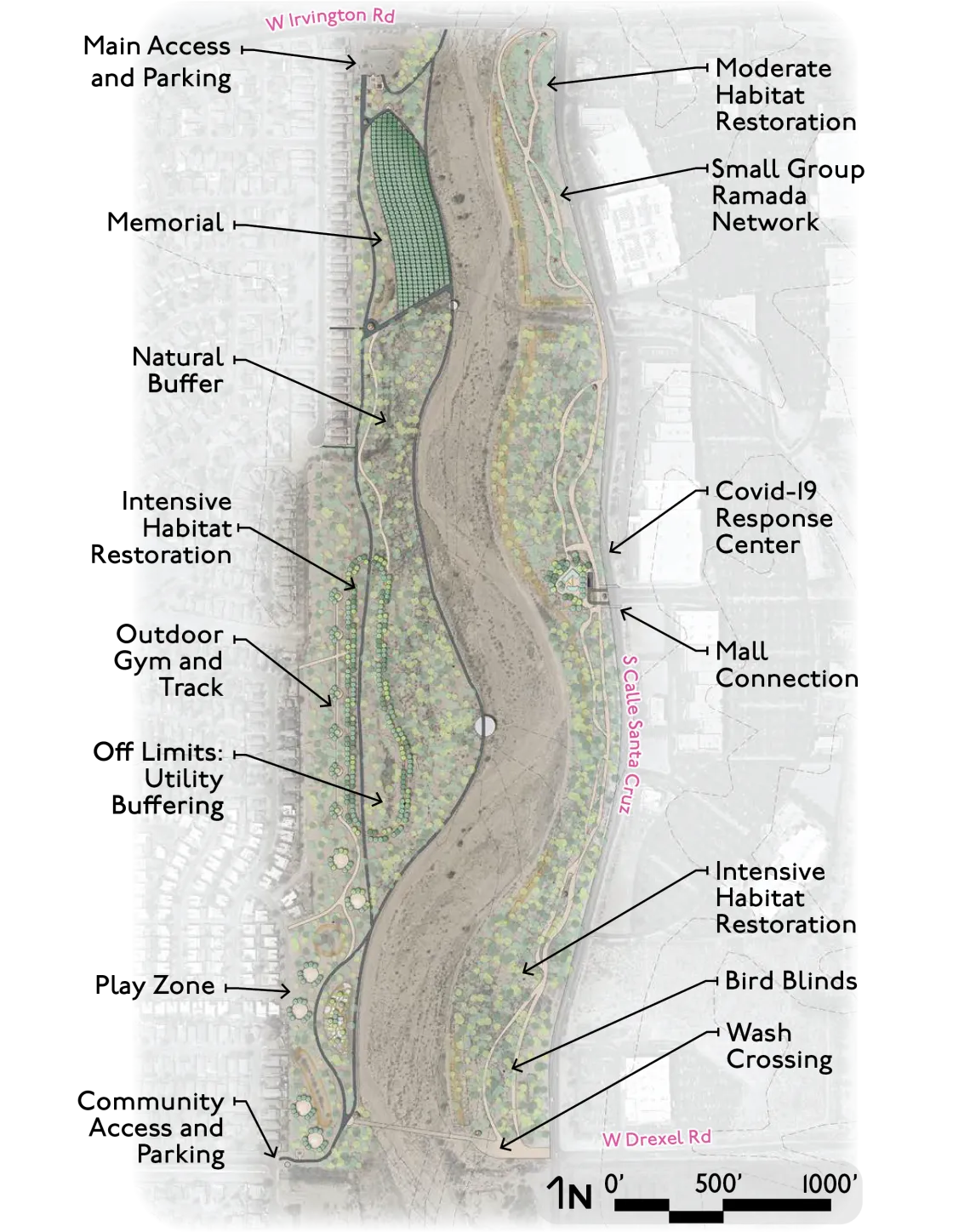
Hope Rock Park Master Plan. Image by Paige Anthony and Ramzy Bejjani.
Play and Exercise Grounds
One of the team's primary goals was to create a park that would "provide visitors with joy, health and hope." Embankment slides, exercise stations, bird blinds and circuitous walking paths give visitors a number of ways to engage with the site.

Cross section of Hope Rock Park showing a variety of activity spaces. Image by Paige Anthony and Ramzy Bejjani.
COVID-19 Response and Event Center
A flexible-use area along the east side of the park provides space for medical screening and treatment during periods of public health crisis. This same spot can be transitioned into a public gathering area in the post-pandemic future.
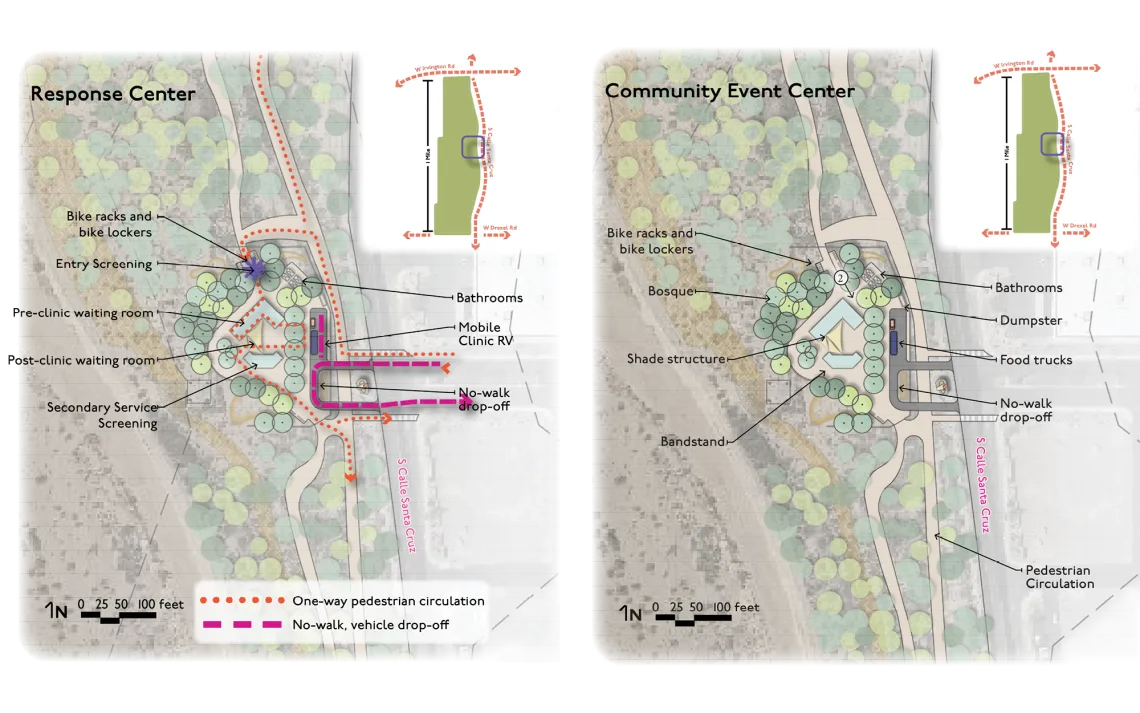
The Response Center circulation plan allows ample space for physical distancing and accommodates vehicle and foot traffic for access to screening and vaccination clinics. Post-COVID, it becomes the Event Center. Image by Paige Anthony and Ramzy Bejjani.
Bird Habitat
The team found much of the site denuded from vegetation, leading to erosion along the Santa Cruz riverbank and further degradation of wildlife habitat. The design by Anthony and Bejjani incorporates a number of strategies to increase vegetative cover and habitat, mitigate erosion, provide shade for visitors and increase biomass and soil health through on-site decomposition of tree trimmings. They considered the site’s location within the larger regional bird habitat network, at the juncture of the Pacific and Central Flyways, and recognized that providing an island of refuge for migrating birds could have an outsized effect on regional bird species.
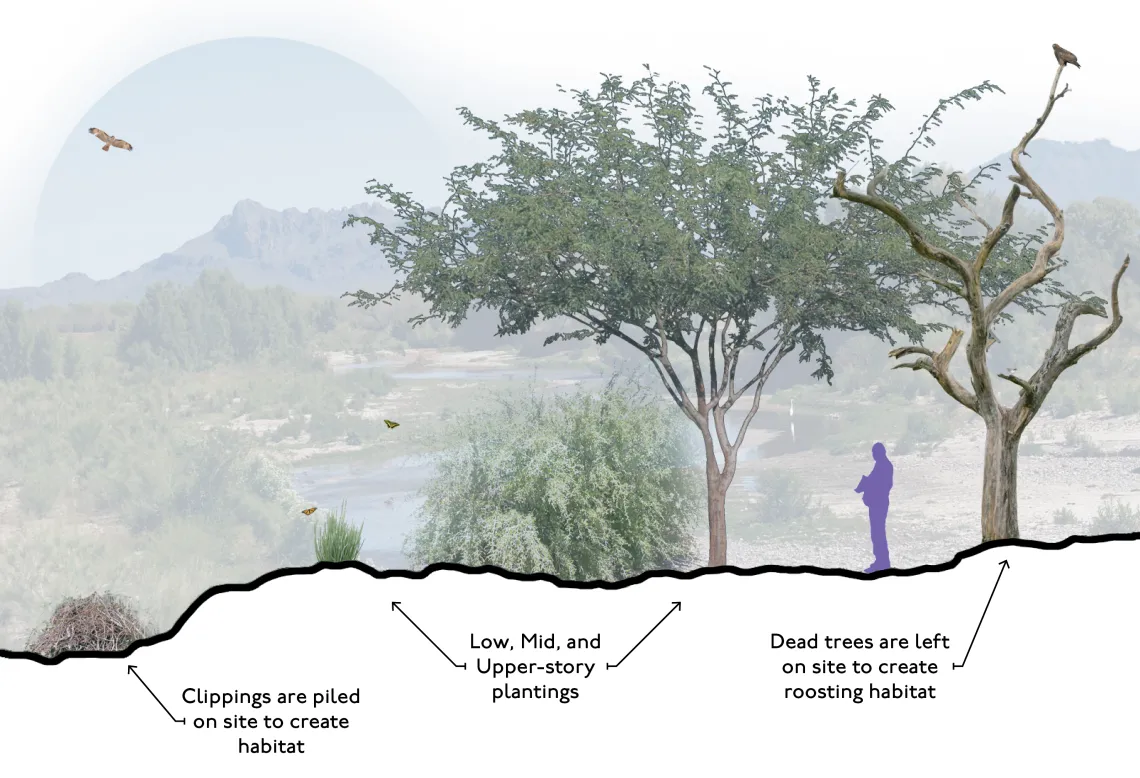
The design uses planting and maintenance strategies intended to provide shade and wildlife habitat. Image by Paige Anthony and Ramzy Bejjani.
Tree Memorial Site
The use of cairns as a wayfinding device is present throughout the park. The small stacks of rocks or stones are used in many cultures to blaze trails and demarcate specific locations, including gravesites. While the park provides wildlife habitat and adaptive spaces for people to safely gather during the COVID-19 pandemic, its primary purpose is to create a place to mourn those who have died from complications of the disease. The park’s Tree Memorial, a dense grove of mesquite trees interspersed with seat-wall terraces, provides spaces for individual altars of memorial and remembrance for COVID-19 victims. The team’s commitment to providing bird habitat onsite also has a dual purpose and contributes to the memorial. “Connecting the earth to the heavens and representing the human soul, birds make their homes in the memorial to those lost to COVID-19,” say Anthony and Bejjani.
The team learned a lot from the experience of designing a park during this unique time in history. "This project has been a unique opportunity to address the impacts of COVID-19 to our community through landscape architecture," says Anthony. "It has been all the more engaging for its timely relevance. I hope my future work can so directly address community challenges and needs."
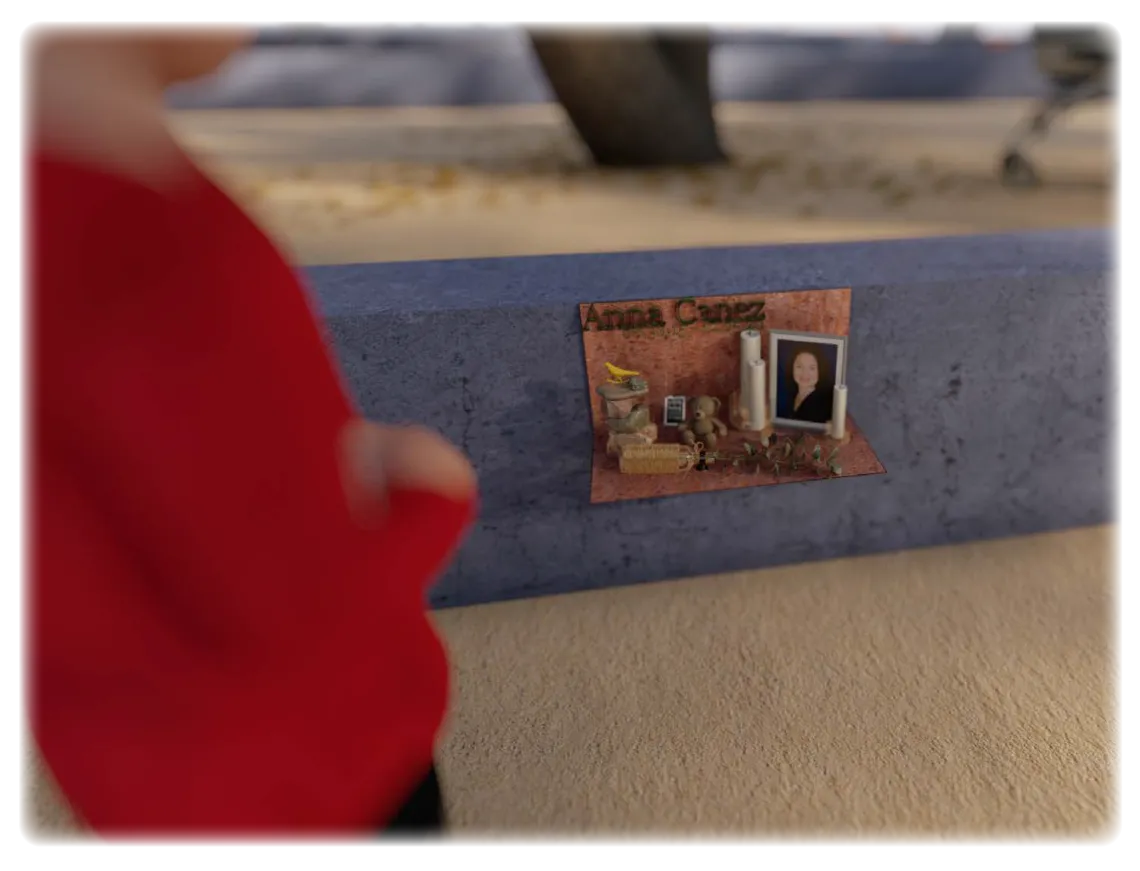
Small altars provide visitors the opportunity to memorialize COVID-19 victims. Image by Paige Anthony and Ramzy Bejjani.
All Design Studio V student teams will be submitting their final projects to the American Society of Landscape Architects Arizona chapter (AzASLA) for student award consideration this January.
Jury Members
- Eric Scharf RLA, Formal Principal, Wheat Design*
- Greg Jackson, Deputy Director, Tucson Parks and Recreation
- Jason Kuklinski PLA, CID, Principal, Norris Design
- Matthew Lutheran MLA, Restoration Program Manager, Tucson Audubon Society
- Alexandra Stoicof PLA, Landscape Architect, Wheat DesignGroup
- Bo Yang PhD, PLA, AICP, Professor of Landscape Architecture and Urban Planning, The University of Arizona
* Donor and non-voting member of the jury.

